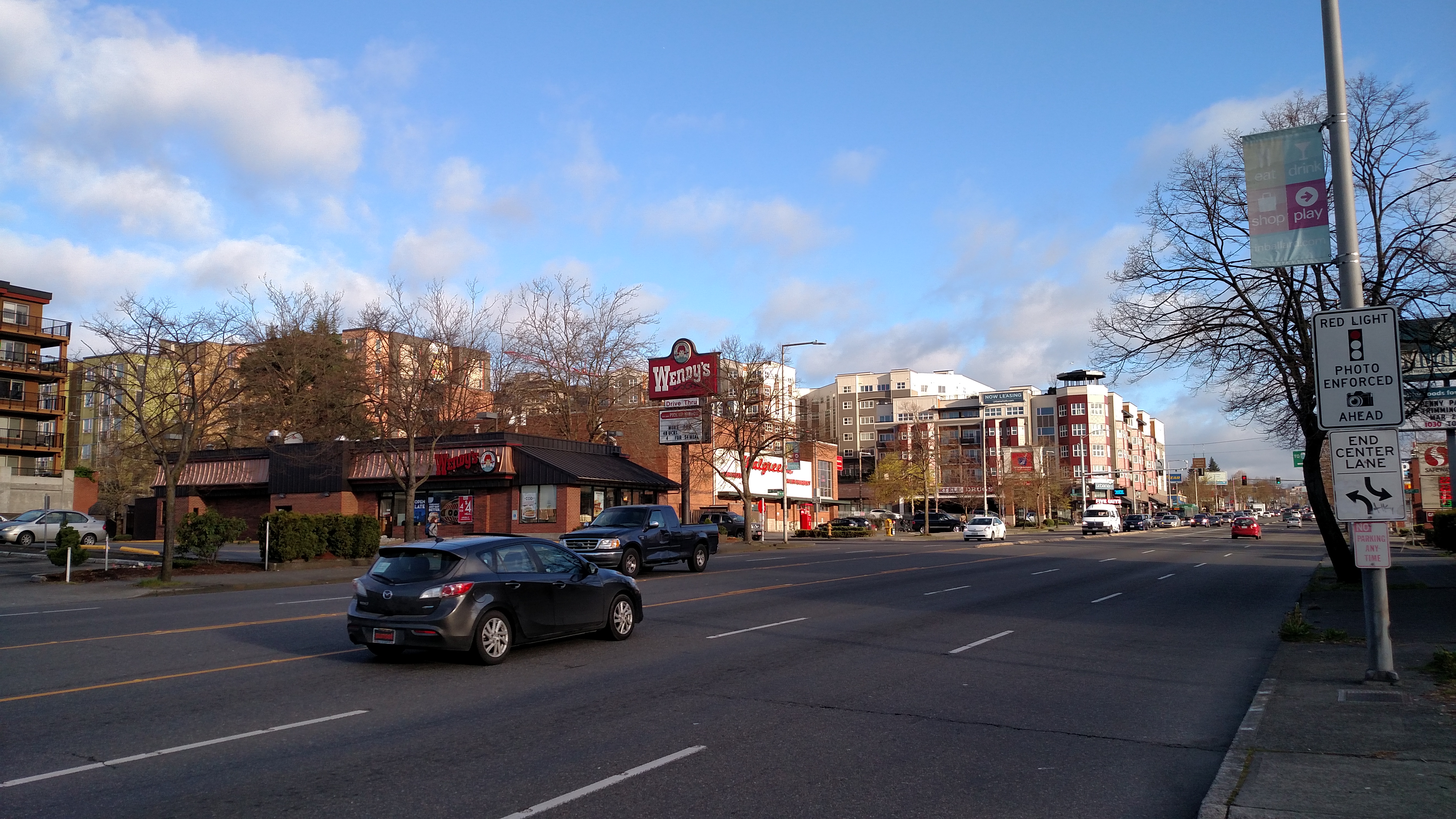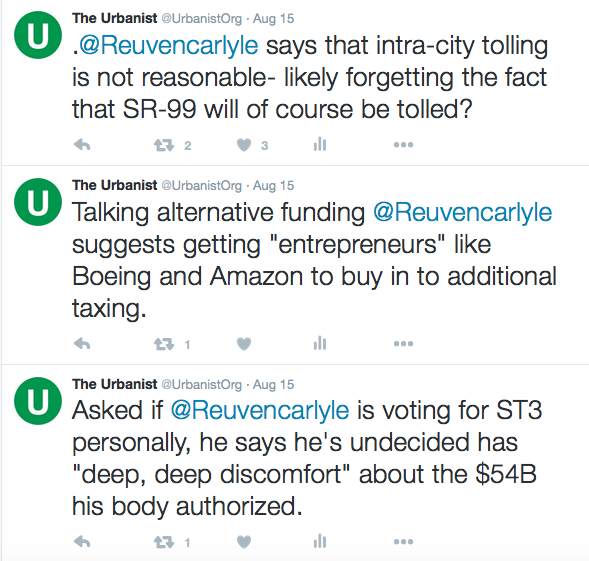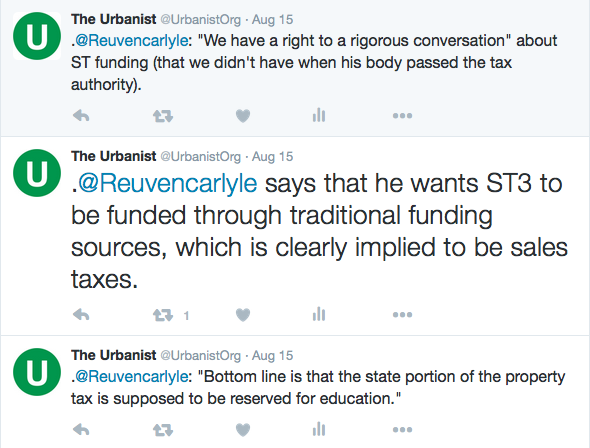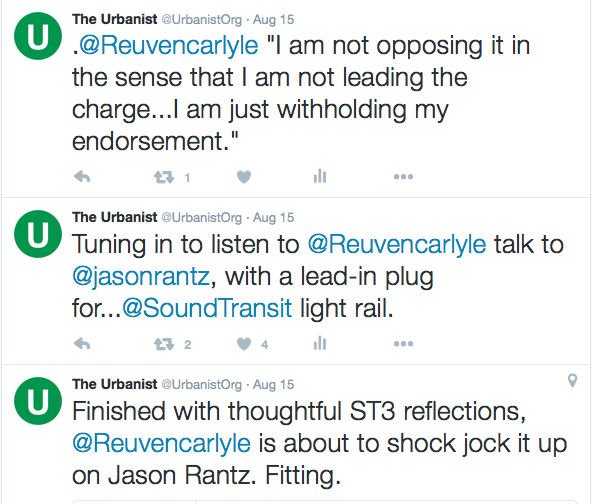State Senator Reuven Carlyle has been in a reflective mood lately. Unfortunately those reflections demonstrate a misunderstanding of the funding issues involved and cavalier attitude toward much needed transit upgrades for his district. Robert Cruickshank penned an excellent rebuttal for The Urbanist. Carlyle posted further reflections that—though conciliatory—didn’t seem to take back anything and seemed to blamed transit advocates for directing anger and harsh words toward him. Yesterday, State Representative Joe Fitzgibbon wrote a thorough takedown of Carlyle’s central point that the property tax funding mechanism takes money away from education and jeopardizes the Legislature’s ability to fulfill its paramount duty to fully fund education.
Fitzgibbon begins with a much needed primer on Washington state law on property taxes:
The state constitution caps property taxes at one percent of fair market value, or roughly $10 of tax per $1,000 of property value. And state law divides that $10 between $5.90 for cities, counties, and local taxing districts; $3.60 for the state (of which the state only currently uses $2.19); and an extra $0.50, colloquially known as “the gap,” in which a few additional taxing districts, deemed high priority public needs by the state, get their taxing authority. The 2015 legislation that then-representative Carlyle approved enacted an 11.9 cent per gallon gas tax increase to fund highway expansion across the state, and allowed Sound Transit several new revenue streams to fund light rail to Everett, Tacoma, Ballard, West Seattle, and Issaquah, including $0.25 in property tax capacity from .50 “gap” fund.
One of the ways lawmakers have proposed complying with the McCleary decision is a “levy swap.” Former Attorney General Rob McKenna endorsed the idea in his 2012 gubernatorial run. Fitzgibbon explains, “The essence of their idea is that the Legislature would increase the state levy from the $2.19 to somewhere between $3.20 and the max $3.60 and lower local school levies (which are not subject to the $10 cap, because they are voter-approved) commensurately.”
This background allows Fitzgibbon to hit upon the crucial point:
The key here is that none of these proposals included using the property tax capacity in “the gap” that the 2015 transportation package allocated to Sound Transit. There has not been a credible proposal for addressing McCleary that incorporated using any of the $0.50 currently allocated for Sound Transit, county emergency and medical services levies, affordable housing levies, and several other purposes the legislature has deemed over the years to be high enough priorities to be protected from the $5.90 cap reserved for other local taxing districts. If there is a proposal to use the $0.50 property tax gap for McCleary purposes, I haven’t heard of it yet.
Fitzgibbon added that nothing obligates the Legislature to reserve “the gap,” or the entirety of the state’s portion for that matter, on education. Nonetheless, Carlyle has patted himself on the back for speaking up for education funding, even if it’s truly as a red herring. Education concern trolling doesn’t get us closer to complying with McCleary. The only way to do that is to get the Senate’s Republican majority to cooperate with the House’s Democratic majority on an equitable funding system. Electing a Democratic majority in both chambers in Olympia this November would perhaps simplify the legislative sausage-making.
As for ST3, it’s not perfect but it’s an idea who’s time has come—in fact it’s well past due. If folks are going to criticize the plan, do it on merits, not on trumped up false choices. And, say what you will about the plan, it does get Ballard, Interbay, and Lower Queen Anne their own grade separated light rail line. If I was Ballard’s state senator, I’d be endorsing ST3 and singing its praises not going on conservative talk radio to give fodder to transit opponents like Carlyle did yesterday. (See the end of this piece for our Twitter recap)
Luckily the 34th District (which covers West Seattle, Burien, White Center and Vashon Island) has a representative in Fitzgibbon trying to do two things at once:
So, while Senator Carlyle tries to parse his position, saying he is not against funding light rail, but simultaneously is not supporting the ballot measure to fund light rail, I hope you’ll join me in in voting “yes” on ST3 this fall. And if the only body that has the ability to build a better tax structure in Washington state, the Legislature, chooses to do so, I hope you’ll join me in that fight too.
We encourage transit advocates to press their legislators about fully funding education. Both issues are crucially important. Why pit them against each other as enemies?
Doug Trumm is publisher of The Urbanist. An Urbanist writer since 2015, he dreams of pedestrian streets, bus lanes, and a mass-timber building spree to end our housing crisis. He graduated from the Evans School of Public Policy and Governance at the University of Washington in 2019. He lives in Seattle's Fremont neighborhood and loves to explore the city by foot and by bike.






